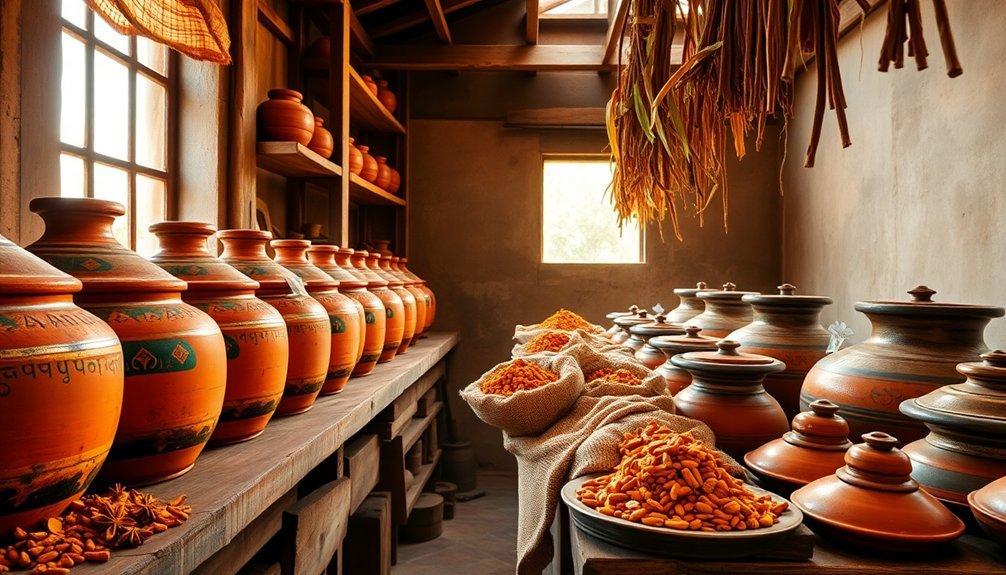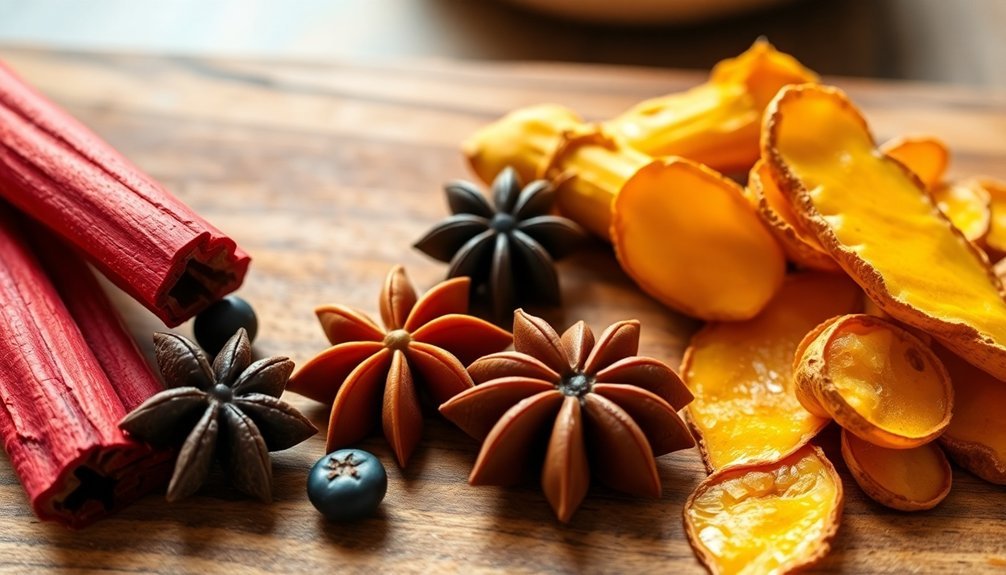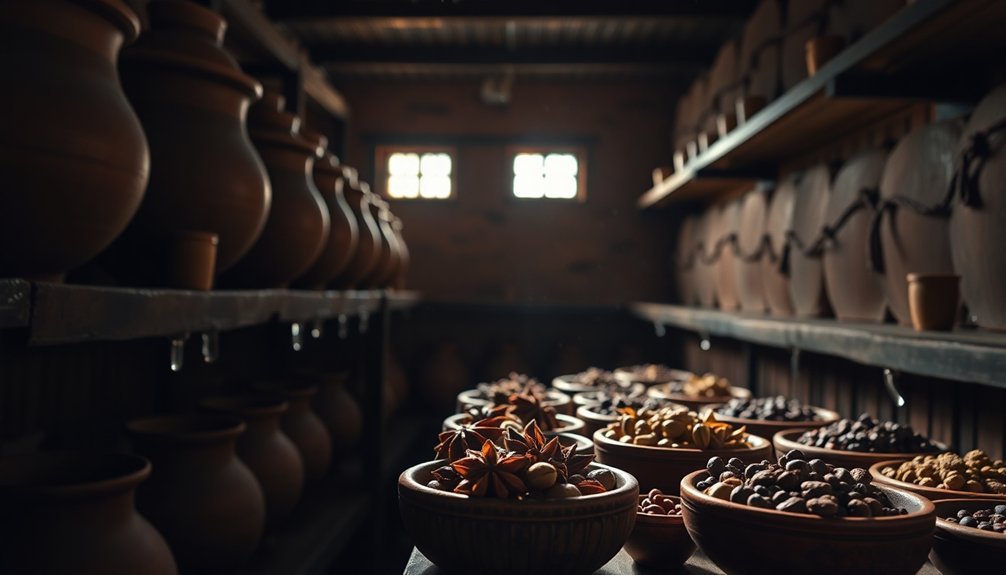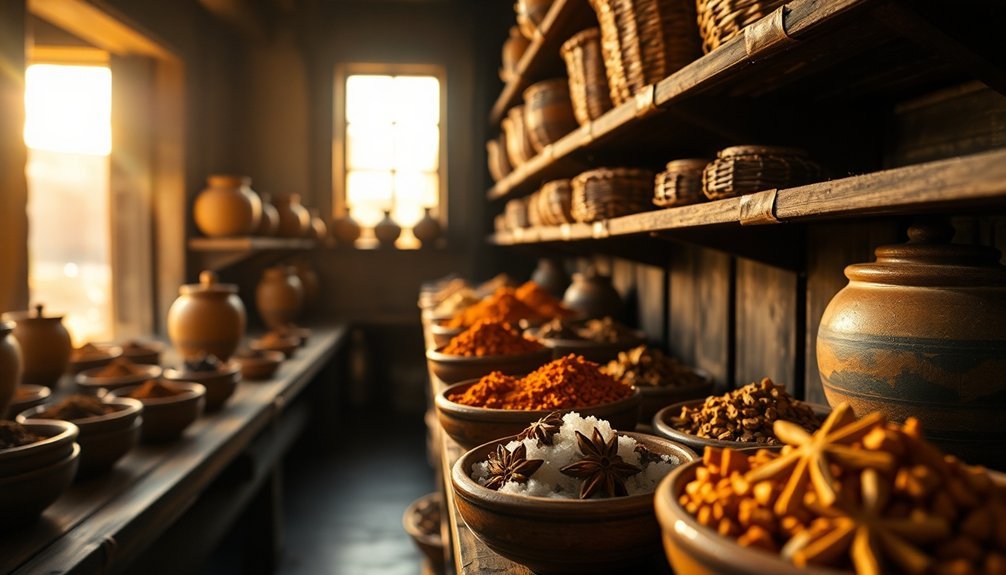Asian spices stay fresh for centuries through their natural antimicrobial compounds and time-tested preservation methods. You'll find these spices contain protective phytochemicals that fight off bacteria, fungi, and other harmful microorganisms. Traditional storage techniques use airtight containers made of glass or ceramic, kept in cool, dark places away from heat and moisture. Salt-based preservation creates barriers against microbial growth, while ancient drying and toasting processes enhance both flavor and longevity. Sacred handling rituals and precise blending practices passed down through generations guarantee these precious ingredients maintain their potency. The secrets of Asian spice preservation run far deeper than modern convenience.
Ancient Wisdom of Spice Storage

For centuries, Asian cultures have mastered the art of preserving spices through careful storage methods that we still rely on today. You'll find that these time-tested techniques focus on protecting spices from their greatest enemies: heat, light, moisture, and air. Many spices contain natural antimicrobial compounds that help them resist spoilage when properly stored.
When you're storing your Asian spices, you'll want to keep them in a cool, dark pantry or cupboard far from your stove and other heat sources. This traditional wisdom aligns perfectly with modern storage recommendations.
You'll need airtight containers, preferably glass jars with tight-fitting lids, to prevent moisture and air from compromising your spices' potency.
If you're looking to preserve your spices for extended periods, you can freeze them just as ancient traders did in cold storage caves. Today's freezing methods can keep your spices fresh for up to two years when stored in proper containers.
Don't forget to label everything with dates, so you can rotate your stock effectively.
You'll find that these ancient storage principles work remarkably well because they address the fundamental factors that affect spice preservation: temperature control, light exposure, moisture prevention, and air exposure.
Salt-Based Preservation Through Time
Salt's ancient role in preservation continues to influence modern spice storage techniques. You'll find that salt-based preservation methods have evolved into sophisticated practices that extend the life of your favorite Asian spices and herbs. When you're working with salt preservation, you're tapping into time-tested techniques that create protective barriers against microbial growth while maintaining flavor profiles. Ancient Chinese texts from 4700 years ago first documented salt's crucial preservative properties.
- Picture salt crystals forming a glistening protective shield around delicate herb leaves, drawing out moisture while locking in essential oils.
- Envision layers of aromatic spices nestled between pristine white salt grains, creating a natural preservation system.
- Imagine the transformation of chili peppers through salt fermentation, developing complex flavors while staying preserved.
- Visualize the careful process of brining, where spices and vegetables dance in a perfectly balanced saltwater solution.
You can apply these preservation methods through various techniques: brining for vegetables and whole spices, salt packing for herbs, blending for seasoned mixtures, and fermentation for enhanced flavors.
Each method offers unique benefits, from the simple coating of herbs with salt to the complex fermentation processes used in traditional Asian condiments. These techniques don't just preserve – they often enhance the original flavors of your spices.
Natural Antimicrobial Defense Systems

You'll find that Asian spices contain powerful plant defense mechanisms that naturally ward off harmful microorganisms through their phytochemical compounds.
These protective substances, including eugenol in cloves and curcumin in turmeric, work together to create an effective antimicrobial barrier in your food.
When you combine multiple spices in Asian cooking, you're actually leveraging their synergistic properties to enhance both preservation and flavor, as these compounds complement and amplify each other's protective effects.
This preservation capability has been recognized since ancient times, when spice trade routes were established to transport these valuable ingredients across continents.
Inherent Plant Defense Mechanisms
Nature's defense arsenal within spices represents millions of years of evolutionary adaptation, producing powerful compounds that protect plants against various threats.
When you examine spices closely, you'll find they're packed with secondary compounds like phenylpropanoids, which plants have developed through countless generations of survival against predators and pathogens.
These natural defense mechanisms work like a sophisticated security system, where plants synthesize specific compounds along specialized pathways to ward off threats.
You'll discover that spices like garlic, allspice, and oregano contain potent chemicals that deter everything from hungry insects to invasive fungi.
- Picture a clove of garlic releasing its pungent compounds when crushed, creating an invisible shield against bacterial invaders.
- Imagine oregano leaves secreting aromatic oils that repel destructive insects.
- Visualize ginger's zingy gingerol compounds acting as a natural pesticide.
- See curcumin in turmeric creating a bitter barrier against herbivorous animals.
These defense mechanisms not only protect the plants in nature but also explain why these spices maintain their potency and freshness over extended periods, making them valuable preservatives in human food systems.
Phytochemical Preservation Properties
Phytochemical compounds in Asian spices pack a powerful punch against harmful microorganisms, acting as nature's own preservatives. You'll find that these natural compounds effectively combat a wide range of bacteria, including dangerous strains like Salmonella, E. coli, and Listeria. When you use spices like garlic, onion, and oregano in your cooking, you're not just adding flavor – you're incorporating powerful antimicrobial agents.
What's particularly impressive is how these spices work on multiple fronts. They don't just fight bacteria; they're also effective against fungi, yeasts, and even viruses. When you're cooking with cloves or black pepper, you're tapping into nature's antifungal arsenal.
These properties explain why spices have been essential in food preservation throughout history, especially in hot climates.
You can maximize these preservation benefits through various cooking methods. Whether you're creating spice-infused edible coatings, using spices in fermentation, or incorporating them into marinades, you're engaging their natural ability to extend food's shelf life.
The essential oils in spices like rosemary and basil work particularly well at preventing oxidation and maintaining food freshness.
Active Compound Synergies
The remarkable power of Asian spices lies in their complex interactions between multiple bioactive compounds. When you combine different spices, you're actually creating a powerful natural defense system that's far more effective than using single ingredients alone.
These compounds, including alkaloids, flavonoids, and tannins, work together to create a robust antimicrobial shield that's particularly effective in hot climates where food spoilage is a major concern.
You'll find that these natural preservatives evolved to protect plants, and they're now working to protect your food through several fascinating mechanisms:
- Secondary compounds attack bacterial cell walls while others disrupt their metabolism
- Essential oils create protective barriers that prevent microbial growth
- Phenolic compounds strengthen the overall antimicrobial effect
- Multiple compounds working together overcome bacterial resistance mechanisms
What's particularly interesting is that you can't simply isolate one compound and expect the same results. It's the synergistic effect of these various components that makes Asian spices so effective at preservation.
When you combine spices like garlic, oregano, and allspice, you're creating a natural preservation system that's been proven effective across centuries of use.
Traditional Drying and Processing Methods
Ancient drying and processing techniques form the backbone of Asian spice preservation, spanning centuries of culinary tradition. You'll find that traditional methods like air drying and sun drying remain highly effective, with air-dried herbs taking about a week to reach the perfect crumbly texture in dark, temperate conditions.
For turmeric specifically, you'll need to start with the vital curing process, boiling the rhizomes for 45-60 minutes until froth appears. After curing, you can either sun-dry the slices for 10-15 days on cement floors or bamboo mats, or use hot air drying at 60°C for faster results in commercial settings.
When it comes to processing, you'll want to toast your whole spices before grinding to reveal their full aromatic potential. A quick 2-3 minutes in a dry skillet will release the essential oils and enhance their flavors.
You can then grind them using a spice grinder or mortar and pestle to achieve a fine powder. Remember that proper drying and immediate storage in airtight containers after grinding are essential steps that help preserve the spices' potency and flavor for extended periods.
Climate Control in Asian Cultures

Throughout Asia's rich culinary heritage, precise climate control methods have evolved to protect treasured spices from environmental threats. You'll find these time-tested practices still in use today, from traditional Chinese medicine shops to Indian spice markets, where merchants carefully shield their valuable seasonings from heat, light, and moisture.
To maintain peak freshness, you'll want to follow these ancient Asian preservation techniques that have proven effective for centuries:
- Store your spices in dark-colored ceramic or glass containers, similar to those used in Japanese households, where they're protected from harmful UV rays.
- Place containers in cool, shadowy spaces like traditional Asian pantries, away from cooking areas and steam.
- Use tight-fitting lids or stoppers, much like those found on traditional Chinese spice jars, to prevent moisture and air infiltration.
- Keep your spices in dedicated storage areas that maintain consistent temperatures, following the example of traditional Asian spice merchants.
When you're cooking, don't sprinkle spices directly into steaming pots, as this can introduce moisture into your storage containers. Instead, use a dry spoon and close containers immediately after use, just as Asian cooks have done for generations.
Sacred Spice Handling Rituals
You'll find that ancient Asian cultures used specially consecrated vessels made of bronze, clay, or wood to store sacred spices like saffron, ensuring both physical preservation and spiritual potency.
Before grinding spices for religious ceremonies, you must perform specific blessing rituals that honor the sacred nature of these precious ingredients.
During seasonal harvest moon ceremonies, you're expected to participate in communal spice preservation rituals where elders pass down traditional storage methods while offering prayers and blessings.
Ancient Storage Sacred Vessels
Sacred vessels and rituals played a vital role in preserving Asian spices during ancient times.
You'll find that ancient civilizations carefully selected materials like gold, silver, and copper for their spice containers, believing these metals possessed both practical and spiritual protective qualities.
They'd craft intricate vessels adorned with prayers and symbols, often incorporating precious stones and rare woods to enhance the spiritual connection between the container and its contents.
When you examine ancient spice storage practices, you'll notice these vessels weren't just functional – they were sacred objects requiring specific handling protocols:
- Priests would purify their hands before touching the containers
- Dedicated tools were used exclusively for transferring spices
- Containers were sealed with natural waxes and resins during specific lunar phases
- Each vessel bore unique markings indicating its contents and spiritual significance
The combination of precious metals, spiritual symbolism, and meticulous craftsmanship guaranteed these vessels maintained the spices' freshness while honoring their cultural importance.
You'll find these containers stored in temples and monasteries, where religious leaders carefully documented their maintenance and use in ancient texts.
Blessing Before Spice Grinding
Traditionally, Asian spice grinding begins with a series of mindful blessings that honor both the ingredients and their spiritual essence. You'll find this practice deeply rooted in Southeast Asian cultures, where spices aren't just culinary ingredients but sacred elements of wellness and spirituality.
| Blessing Step | Sacred Purpose |
|---|---|
| Silent Prayer | Invokes spiritual protection and potency |
| Smoke Cleansing | Purifies the grinding space with incense |
| Touch Ritual | Connects handler's energy with spices |
| Gratitude Offering | Acknowledges nature's gifts |
| Mindful Intention | Sets purpose for spice preparation |
Before you begin grinding, you'll need to understand that this isn't just about preparation – it's a meditative process that's been practiced for millennia. In traditional Asian homes, you'll often see spices being blessed in specific vessels, especially when preparing medicinal blends or ritual offerings. This practice is particularly evident in Ayurvedic traditions, where the spiritual energy of spices is believed to enhance their healing properties. You'll notice that many practitioners still maintain these rituals today, especially when grinding turmeric, holy basil, or preparing traditional curry blends.
Seasonal Harvest Moon Ceremonies
Moonlit autumn nights transform Asian spice-handling rituals into profound cultural ceremonies during the harvest season.
You'll find families gathering under the full moon to express gratitude for nature's bounty, including precious spices and herbs that'll be preserved for the coming year. During these ceremonies, you'll witness the careful placement of offerings that honor both the harvest and ancestral wisdom in spice preservation.
Traditional moon-viewing platforms become sacred spaces where you'll participate in these time-honored rituals:
- Arranging white tsukimi dango in pyramids alongside freshly harvested spices, symbolizing the connection between earth's gifts and celestial guidance.
- Placing susuki grass around spice-drying areas to ward off negative energies that might affect preservation.
- Setting out seasonal fruits and vegetables with aromatic spices in specific patterns that align with lunar energy.
- Performing ceremonial spice-grinding as community elders share ancient preservation techniques.
You're participating in a tradition that's woven into the fabric of Asian spice culture, where the harvest moon doesn't just illuminate the night – it guides the timing of spice collection, blessing, and storage practices that have preserved flavors for centuries.
Regional Preservation Techniques

Three distinct approaches have shaped Asia's regional spice preservation techniques: environmental control, container selection, and advanced preservation methods. You'll find these time-tested practices still in use across the continent, preserving spices' potency for extended periods.
In environmental control, you'll need to store your spices away from heat sources and direct sunlight. Asian cultures have long recognized that consistent, cool temperatures are vital for maintaining spice quality. You can maximize freshness by keeping your spices in a dedicated pantry or cabinet with stable conditions.
When it comes to containers, you'll want to follow the Asian tradition of using airtight vessels. From Chinese lacquered wood tea canisters to traditional clay pots, these containers protect spices from moisture and air exposure. Today, you can achieve similar results using glass jars with tight-fitting lids or vacuum-sealed bags.
For advanced preservation, you'll benefit from bio-preservation techniques like fermentation and salt-based methods. You can preserve spices through salt packing or fermentation, similar to kimchi-making processes.
If you're looking for modern solutions, freezing spices in airtight containers can extend their life up to two years.
Heritage Spice Blending Practices
While proper storage keeps spices fresh, the art of blending them creates the soul of Asian cuisine. You'll find centuries-old practices that showcase how different regions master the delicate balance of flavors, from Chinese Five Spice to Japanese Shichimi Togarashi.
These heritage blending techniques aren't just about mixing spices; they're about creating harmonious combinations that enhance both the dish's taste and its medicinal properties.
When you're working with Asian spice blends, you'll notice they follow specific ratios that have been perfected over generations. The process often involves careful roasting and grinding, followed by tempering in hot oil to release deeper flavors. You can adapt these traditional blends to your taste while maintaining their essential character.
- Dry-roasting coriander seeds until they pop and release their citrusy aroma
- Grinding fresh turmeric root with ginger to create a vibrant golden paste
- Tempering whole cumin seeds in hot oil until they crackle and dance
- Crushing star anise pods to release their licorice-like essence
These heritage practices don't just preserve flavors; they're living traditions that continue to influence global cuisine while maintaining their cultural significance.
Frequently Asked Questions
Can Radiocarbon Dating Determine the Exact Age of Preserved Asian Spices?
No, you can't rely on radiocarbon dating for exact spice age because preserved spices often lack sufficient organic material, may be processed or mixed, and could fall outside the method's reliable dating range of 500-50,000 years.
Do Asian Spices Retain Their Medicinal Properties After Centuries of Storage?
You can't rely on centuries-old spices for medicinal benefits, as their properties considerably degrade over time. Even with perfect storage, they'll lose most therapeutic compounds within years, not centuries, becoming less effective.
How Do Lunar Cycles Influence Traditional Asian Spice Preservation Methods?
You'll find that traditional Asian spice preservation aligns with lunar phases – harvest during waning moons when sap's low, dry during new moons, and store during waxing moons for ideal potency and longevity.
What Role Did Ancient Trade Routes Play in Spice Preservation Techniques?
You'll find that ancient trade routes taught merchants essential preservation techniques, as they'd learn to dry spices properly, store them in cool conditions, and utilize monsoon patterns to prevent spoilage during long journeys.
Were Specific Containers or Materials Considered Taboo for Storing Sacred Spices?
You'll find that certain cultures prohibited storing sacred spices in non-traditional containers. Native American traditions, for example, don't allow sacred herbs like white sage to be kept in modern, commercial vessels.
In Summary
You'll find that Asia's time-tested spice preservation methods aren't just practical – they're a fascinating blend of science and tradition. From salt-based preservation to sacred handling rituals, these techniques have kept spices fresh for generations. When you combine careful drying, natural antimicrobials, and precise climate control with ancestral knowledge, you're tapping into centuries of wisdom that keeps these precious seasonings potent and flavorful.





Leave a Reply